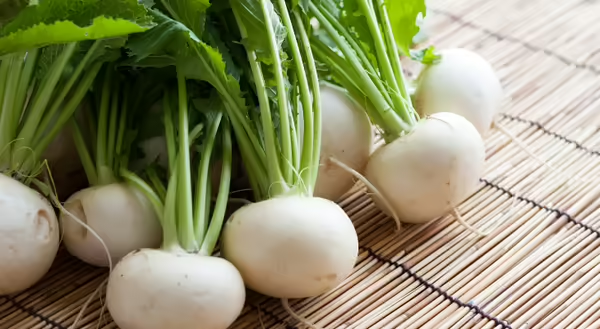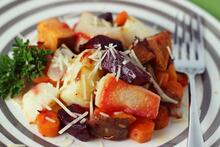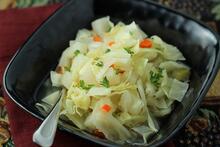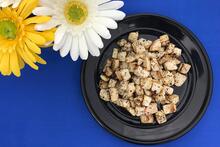
I don't remember growing up eating turnips. And while turnips are not my go-to veggie, I enjoy grabbing an occasional bunch when I visit farmers markets or local farms each year, primarily to shake up my food routine.
If you enjoyed turnips as a kid (or as an adult), how did your family cook and serve them? Write about your experience on social media and tag Illinois Extension.
Nutritionally, 1/2 cup cubed turnips contains around 18 calories, 4g carbohydrates, and 1g fiber, and is a source of vitamins and minerals, including folate, vitamin C, and potassium. Turnips are not a significant source of fat, protein, or sodium.
- Buy: Look for turnips that are heavy for their size, with smooth skin and without soft spots or cracks. Smaller turnips are sweeter, while large turnips tend to be woodier and more bitter. Sometimes, turnip greens will still be attached to the turnips. Look for greens that are deep green in color and not wilted or limp.
- Grow: Check out the Illinois Vegetable Garden Guide page on turnips for suggested varieties to grow. They grow quick and can be a fun family gardening activity!
- Price: Turnips are available year-round in stores, and come into season in Illinois in spring and fall. Buying in-season tends to reduce the price.
- Store: If greens are still attached, cut them off and store separately from the turnips. Add turnips to a food-safe container or bag and refrigerate 1-2 weeks. Also store turnip greens in the refrigerator and use within a few days, as they wilt quickly.
- Prepare: Wash turnips before preparing. Use vegetable peeler to remove skin. Cut into desired sized pieces. Montana State University Extension has a nice step-by-step guide on cutting turnips.
- Preserve:
- Turnips: Save turnips for longer storage with freezing instructions from the National Center for Home Food Preservation (NCHFP). Michigan State University Extension has instructions for canning turnips, with an advisory that turnips "usually discolor and develop strong flavor when canned."
- Turnip Greens: NCHFP also has instructions for freezing the greens. For those that like to watch steps, watch my freezing turnip greens video filmed during stay-at-home in 2020.
- Eat: Turnips can be eaten raw or cooked. The greens make a great substitute for recipes already using kale or collard greens.
Roasted Root Vegetables | Print recipe
serves 4
Cabbage and Ham Bone Soup | Print recipe
serves 8
Lemon and Rosemary Roasted Turnips | Print recipe
serves 6
Resources:
-
Eat.Move.Save. Illinois Extension, Turnips, N/D
-
Nebraska Extension, Turnips and Rutabagas, N/D
- Oklahoma State University, Mashed Potatoes with a Turnip Twist (Video), 2019
-
Purdue Extension, FoodLink: Turnip and Turnip Greens, N/D
-
South Dakota State University Extension, Turnip and Rutabaga, 2022
-
Utah State University Extension, How to Cook with Turnips (Video), 2010
- United States Department of Agriculture, FoodData Central
Post originally published in 2016; content updated in 2022.
Healthy Eats and Repeat
How much difference is there between canned and frozen foods? How should you cook venison? When is the best time to buy avocados? Get answers to these questions as well as other tips, tutorials and recipes for common kitchen foods and items with University of Illinois Extension Nutrition & Wellness Educator Caitlin Mellendorf’s blog Healthy Eats and Repeat. Build your best life. Trust Extension to help.
Caitlin Mellendorf is an Illinois Extension Nutrition and Wellness Educator serving DeWitt, Macon and Piatt Counties in Central Illinois. She is a Registered Dietitian and her work focuses on helping community members gain the knowledge, skills and tools to live healthier, more nutritious lifestyles. This includes providing programs and answering questions about heart health, diabetes, food safety, food preservation, grocery shopping and cooking. You can reach Caitlin by email at chuth2@illinois.edu or call 217.877.6042. Check out her nutrition blog Healthy Eats and Repeats for seasonal recipes and of an exploration of common kitchen foods.


